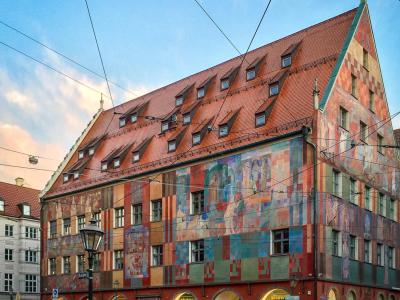Weberhaus (Weaver's House), Augsburg
Dating back to 1389, the Weaver's House initially served as the headquarters of the weavers' guild until its dissolution in 1548. During the medieval era, it was a central hub for the textile trade in Augsburg. The original weavers' house underwent renovations, and its purpose evolved into the distribution of imported cotton among guild members. The building featured vibrant facade paintings, highlighting its historical importance.
Between 1605 and 1607, Matthias Kager, a renowned Augsburg city painter and mayor, adorned the outer wall with intricate frescoes. In April 1863, the Weberhaus was auctioned off, leading to a complete interior redesign. This transition included the removal of the wooden paneling in the guild room, painted by Peter Kaltenhoff in 1457. The Weberhaus subsequently became part of the Bavarian National Museum.
At the dawn of the 20th century, due to the deteriorating condition of the old weaver's house, it was eventually demolished, despite protests. In its place, a new building, designed by architect Otto Holzer and following a similar layout, was erected in 1913.
Prior to the demolition, remnants of original frescoes were uncovered on the outer facade, now preserved in the Maximilian Museum. Notably, the ceiling and wall paneling of the former guild room, considered one of the most extensive late Gothic picture cycles north of the Alps, were saved and relocated to the Bavarian National Museum in Munich.
The barrel vault within the Weberhaus boasts scenes featuring verses from the Old Testament and episodes from the life of Alexander the Great. The north wall showcases electors, emperors, and heroic figures, along with scenes from the story of creation. The east wall is adorned with depictions of Jewish prophets and pagan philosophers.
Between 1605 and 1607, Matthias Kager, a renowned Augsburg city painter and mayor, adorned the outer wall with intricate frescoes. In April 1863, the Weberhaus was auctioned off, leading to a complete interior redesign. This transition included the removal of the wooden paneling in the guild room, painted by Peter Kaltenhoff in 1457. The Weberhaus subsequently became part of the Bavarian National Museum.
At the dawn of the 20th century, due to the deteriorating condition of the old weaver's house, it was eventually demolished, despite protests. In its place, a new building, designed by architect Otto Holzer and following a similar layout, was erected in 1913.
Prior to the demolition, remnants of original frescoes were uncovered on the outer facade, now preserved in the Maximilian Museum. Notably, the ceiling and wall paneling of the former guild room, considered one of the most extensive late Gothic picture cycles north of the Alps, were saved and relocated to the Bavarian National Museum in Munich.
The barrel vault within the Weberhaus boasts scenes featuring verses from the Old Testament and episodes from the life of Alexander the Great. The north wall showcases electors, emperors, and heroic figures, along with scenes from the story of creation. The east wall is adorned with depictions of Jewish prophets and pagan philosophers.
Want to visit this sight? Check out these Self-Guided Walking Tours in Augsburg. Alternatively, you can download the mobile app "GPSmyCity: Walks in 1K+ Cities" from Apple App Store or Google Play Store. The app turns your mobile device to a personal tour guide and it works offline, so no data plan is needed when traveling abroad.
Weberhaus (Weaver's House) on Map
Sight Name: Weberhaus (Weaver's House)
Sight Location: Augsburg, Germany (See walking tours in Augsburg)
Sight Type: Attraction/Landmark
Guide(s) Containing This Sight:
Sight Location: Augsburg, Germany (See walking tours in Augsburg)
Sight Type: Attraction/Landmark
Guide(s) Containing This Sight:
Walking Tours in Augsburg, Germany
Create Your Own Walk in Augsburg
Creating your own self-guided walk in Augsburg is easy and fun. Choose the city attractions that you want to see and a walk route map will be created just for you. You can even set your hotel as the start point of the walk.
Augsburg Introduction Walking Tour
Augsburg, one of Germany's oldest cities, was founded in 15 BC by the Romans as Augusta Vindelicorum and was named after the Roman emperor Augustus. Due to its strategic location on trade routes to Italy, Augsburg became a thriving commercial hub. It got the status of a Free Imperial City in 1276.
Throughout the 15th-16th centuries, Augsburg enjoyed prosperity driven by textile production,... view more
Tour Duration: 2 Hour(s)
Travel Distance: 3.6 Km or 2.2 Miles
Throughout the 15th-16th centuries, Augsburg enjoyed prosperity driven by textile production,... view more
Tour Duration: 2 Hour(s)
Travel Distance: 3.6 Km or 2.2 Miles




